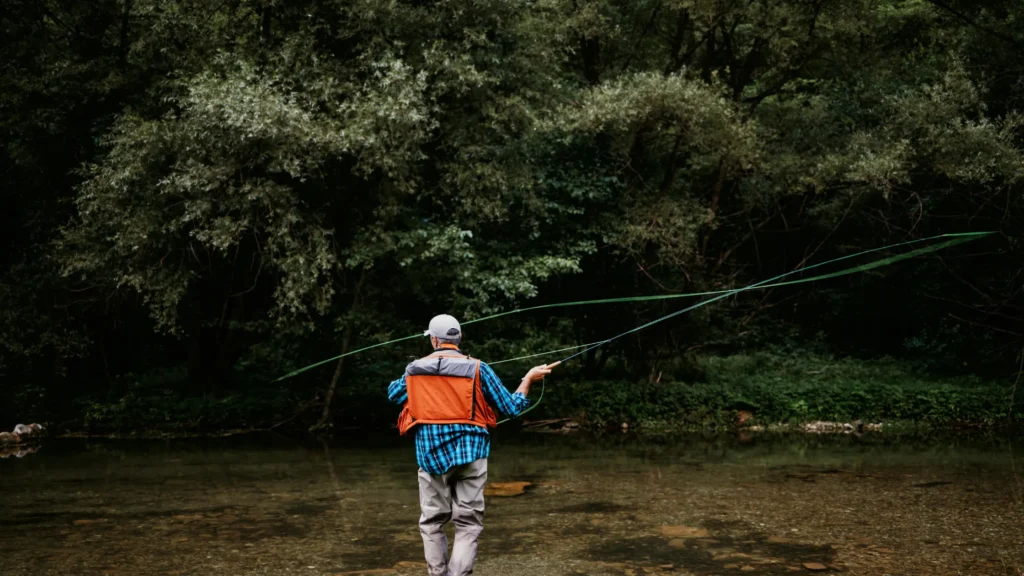When I first began my journey into the world of fly fishing, I was eager to learn all the various tips and tricks, including mastering casting techniques and tying the perfect fly fishing knots. As a beginner, I found myself seeking out fly fishing lessons, investing in the right gear, and even researching the best fly fishing spots. Throughout this process, one question kept coming up: is fly fishing all in the wrist?
Yes, Fly fishing is in the timing and technique of wrist usage. Mastering the skill of casting with a delicate flick of the wrist is critical for anyone who wants to go fly-fishing. Having the appropriate wrist motion in fly-fishing is of utmost significance.
Table of Contents
The Role of the Wrist in Casting
Providing the necessary rotation to the rod, the wrist plays a crucial role in fly casting, generating the required power for an accurate and efficient cast.
Excessive wrist movement can lead to poor technique, but avoiding it altogether can also be detrimental. Executing a back cast or forward cast correctly requires a controlled and precise rotation of the wrist.
Optimizing casting performance requires finding a balance in wrist movement. A more enjoyable experience on the water can be achieved by significantly improving fly casting technique through practicing proper wrist control and movement.
When practicing fly fishing for beginners, it’s essential to be aware of the role your wrist plays to maximize the efficiency and precision of your casting.
One must consider that fly fishing can be done in various environments – fly fishing in saltwater or small streams, fly fishing during the winter, or even fly fishing with kids. Therefore, the way you use your wrist might depend on the situation. In general, the wrist plays a pivotal role in casting; however, excessive wrist action can lead to less accurate casts. Instead of focusing solely on the wrist, it’s important to rely on the entire arm and body to cast smoothly and effectively.
Fly fishing lessons often teach the necessary techniques, tips, and foundational knowledge. Here are some points to remember when assessing the wrist movement:
- Keep a firm grip on the rod, but avoid squeezing it tightly.
- The motion should involve the forearm and shoulder, with minimal wrist movement during the casting stroke.
- Avoid “breaking” the wrist (excessive bending) during the cast.
Common Mistakes When Using Wrist In Fly Fishing
Too Much Wrist Movement:
One of the most common mistakes made when using wrist movement in fly fishing is overcompensating. Many anglers believe that the more they move their wrist, the farther their cast will go, but this couldn’t be further from the truth. In reality, too much wrist movement can cause a variety of problems, including an inaccurate cast and a loss of power.
When you use your wrist too much, you’re likely to snap your rod tip too high on the backcast and drop it too low on the forward cast. This results in a wide loop and a loss of power, which makes it difficult to place your lure precisely where you want it.
Not Enough Wrist Movement:
Conversely, many anglers make the mistake of not using enough wrist movement when casting. Some may believe that only arm strength is required to perform a proper cast without realizing that precise timing and control with their wrist is also necessary.
Your arm provides power whereas your wrist provides control. Without utilizing some degree of motion from your wrist you will experience difficulty placing your fly where it needs to be or achieving distance while casting.
Incorrect Grip on the Rod:
Finding comfort within your own grip style is another essential aspect when perfecting fly fishing technique. Holding onto or gripping too tightly onto your rod can cause you to lose control or create bad habits .
On the other hand, holding onto it too loosely can lead to poor accuracy during casts as well as fatigue due to trying to compensate for lackluster grip strength. Experimenting with different grips such as thumb on top or thumb below grip can help determine a comfortable style for each angler.
Remember: the correct grip should allow you to cast without discomfort and with enough control for accurate placement of your fly. By avoiding these common mistakes, anglers can become more effective at fly fishing and enjoy the art of the sport even more.
It is important to remember that finding the right balance takes patience, practice, and experience. Making small changes in technique can pay off in big ways when it comes to making successful catches on the water.

Improving Your Wrist Action
First of all, it’s crucial to practice casting regularly. Whether you’re a beginner or an experienced angler, consistency is key to improving your wrist action. Take advantage of fly fishing lessons and commit to regular practice, even when you’re not on the water. As your muscle memory develops, you’ll notice your casts become smoother and more accurate.
- Focus on using short casting strokes for better control.
- Experiment with different fly fishing knots to see which ones work best for you.
- Find a comfortable fly fishing reel that suits your hand and wrist size.
Don’t be afraid to try new techniques and styles of fly fishing. Mixing up your approach can help diversify your skills and strengthen your wrist action.
Here are few more tips for Improving your Wrist Control in Fly Fishing:
Practice with a Lighter Rod:
One of the most effective ways to improve your wrist control in fly fishing is by practicing with a lighter rod. Using a lighter rod requires more precision and control, which can help you develop better technique.
A 3-4 weight rod is an ideal choice for practice since it will require more finesse and control than heavier rods. When practicing with a lighter rod, focus on casting slowly and smoothly.
Keep your wrist movements fluid and controlled, and avoid jerky or abrupt movements. Try to perfect your form before adding speed or distance to your casts.
Focus on Your Grip and Hand Placement:
Another important aspect of improving your wrist control in fly fishing is mastering your grip and hand placement. Your grip should be firm but not too tight, with the thumb on top of the handle and the other fingers wrapped around it. Pay attention to how you hold the rod during casting as well.
The correct hand placement will vary depending on the type of cast you are using, so make sure to consult instructional resources or work with an instructor to determine the proper technique. Maintaining consistent hand placement throughout each cast can help improve accuracy while reducing fatigue or strain on your wrist.
Work with an Instructor to Perfect Your Technique:
Working with an experienced instructor can be incredibly beneficial for improving wrist control in fly fishing. An instructor can provide personalized feedback on your form and technique, as well as offer tips for improvement based on their own experience.
An instructor can also introduce new techniques or casts that don’t rely heavily on wrist movement but still require precise arm motion. This kind of coaching can be particularly helpful if you find yourself struggling with specific aspects of casting or want to expand your skill set beyond basic techniques.
Read More: Why Do Fly Fishermen Stand In The Water? & Is Fly Fishing Hard to Learn?
Final Thoughts: Is Fly Fishing All in the Wrist?
Fly fishing is an art and mastering it requires practice and patience. Yes, the role of the wrist in fly fishing is significant, but it’s not the only element worth considering. In fact, it’s essential to focus on a range of factors, from casting techniques to selecting the appropriate fly fishing gear. If you’re new to fly fishing, I recommend taking this free fly fishing lessons and learning some basic fly fishing knots.
